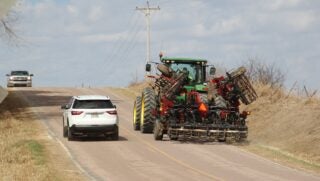If farmers, ranchers and consumers can all agree on one thing in the upcoming Agricultural Act, it is in regards to funding of conservation support and programs, which aide in the improvement of soil, safety of water and wildlife, and access to land, among many other key issues.
Conservation wasn’t introduced into the Farm Bill until the 1980s, when farmers and ranchers saw the need for direct funding from the bill and have benefited from it since its introduction. However, in 2014, roughly $6 billion was cut from the conservation title, which has hindered efforts by farmer and ranchers to access support.
Talks for the 2018 bill hope to increase funding for this title, which sits at about 6 percent of total funding under the Farm Bill. American Farm Bureau’s stance on the title includes maintaining the cap on Conservation Reserve Program at 24 million acres. If you aren’t familiar with this program, it supports farmers in removing qualifying land from production for approximately 10 years. This is a controversial program; many view an increase in the cap as a way to prevent surplus production and thus, increase market prices on crops as well as help to benefit soil, water, wildlife, and air quality. Other’s believe cash rent will increase if land is removed from the CRP and put back into production, and more jobs will be created in areas where business has been slow due to land going long lengths of time without cultivation. However, in the past, when other countries were hurting for food, farmers ditched the CRP, referred to as Soil Banks in the past, in order to grow enough food for the population.
Another portion of the conservation title is the Agricultural Conservation Easement Program. Introduced in the 2014 bill, it combines three previous programs, the Wetlands Reserve Program, the Grassland Reserve Program, and the Farm and Ranch Lands Protection Program, under this umbrella category. These programs encourage preservation of lands for future generations and have become a permanently funded program under the Farm Bill. Decreasing the CRP acreage from 32 million down to 24 million in the 2014 act allowed for greater funding of ACEP. It is important to note that funding for each specific area, wetlands, grasslands, and farm and ranch lands, is much lower than in previous Farm Bills, due to the combination of the three programs and has a mandatory decrease in funding for the 2018 bill from $500 million down to $250 million.
These are only some of the programs enacted to aide in the conservation and preservation of land. Each program supports farmers and ranchers by incentivizing efforts in improving quality of our environment. While needing to protect our future and operations from over-regulation, we also need to continue in our conservation practices to ensure future generations the ability to continue farming. Lobbyists are working hard to increase funding for each of these areas, which, with our budget, means possibly cutting funding in other titles. Regardless, conservation is a much needed segment of the Farm Bill to ensure farmers and ranchers continue to grow their operations while benefiting both the planet, and public.
Markie Hageman is a senior, majoring in agribusiness, at Fort Hays State University. She is actively involved in her state Cattlemen’s Association, Young Farmers chapter, and National Cattlemen’s Beef Association. Follow her series exploring various parts of the next Farm Bill.



